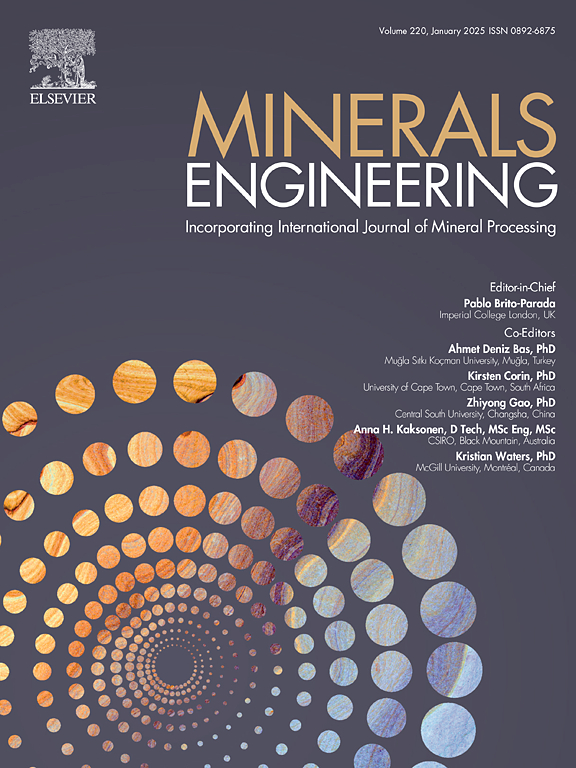利用夹带法对超细颗粒进行重力回收
IF 4.9
2区 工程技术
Q1 ENGINEERING, CHEMICAL
引用次数: 0
摘要
由于超细颗粒在浮选过程中与气泡的碰撞效率较低,且夹带对脉石物料的回收率较高,因此超细颗粒的回收是一个复杂的难题。因此,贵重金属的损失发生了。在本工作中,选择了一种新的方法来回收超细颗粒。代替浮选,夹带被用于基于重力的颗粒回收。设计了一个3d打印的颗粒收集器来回收气泡柱顶部的颗粒。为了更好地了解该过程对密度的依赖关系,采用SiO2、Ni和W颗粒覆盖2.65 ~ 19.28 g⋅cm-3的密度范围。镍和钨的回收率分别为73%和59%。当SiO2的粒径大于10μm时,SiO2的回收率很高(≈50%)。对流动型态进行了广泛的研究,以获得流动型态与颗粒回收结果之间相关性的概述。本文章由计算机程序翻译,如有差异,请以英文原文为准。
Utilization of entrainment for a gravity based recovery of ultrafine particles
Ultrafine particle recovery poses a complicated challenge to be solved, due to the low collision efficiency with bubbles in flotation processes and a high recovery of gangue material by entrainment. As a result, losses of valuable metals occur. In the present work, a novel approach was chosen for the recovery of ultrafine particles. Instead of flotation, entrainment was used for a gravity based particle recovery. A 3D-printed particle collector was designed to recover the particles at the top of a bubble column. To obtain a good understanding about the density dependence of the process, SiO2, Ni and W particles were used to cover a density range of 2.65-19.28 gcm-3. High recoveries were achieved for Ni (73 %) and W (59 %) particles. SiO2 was only recovered in high amounts (50 %) when particle sizes exceeded . An extensive investigation of the flow regime was performed to gain an overview about the correlation in between flow regime and particle recovery results.
求助全文
通过发布文献求助,成功后即可免费获取论文全文。
去求助
来源期刊

Minerals Engineering
工程技术-工程:化工
CiteScore
8.70
自引率
18.80%
发文量
519
审稿时长
81 days
期刊介绍:
The purpose of the journal is to provide for the rapid publication of topical papers featuring the latest developments in the allied fields of mineral processing and extractive metallurgy. Its wide ranging coverage of research and practical (operating) topics includes physical separation methods, such as comminution, flotation concentration and dewatering, chemical methods such as bio-, hydro-, and electro-metallurgy, analytical techniques, process control, simulation and instrumentation, and mineralogical aspects of processing. Environmental issues, particularly those pertaining to sustainable development, will also be strongly covered.
 求助内容:
求助内容: 应助结果提醒方式:
应助结果提醒方式:


